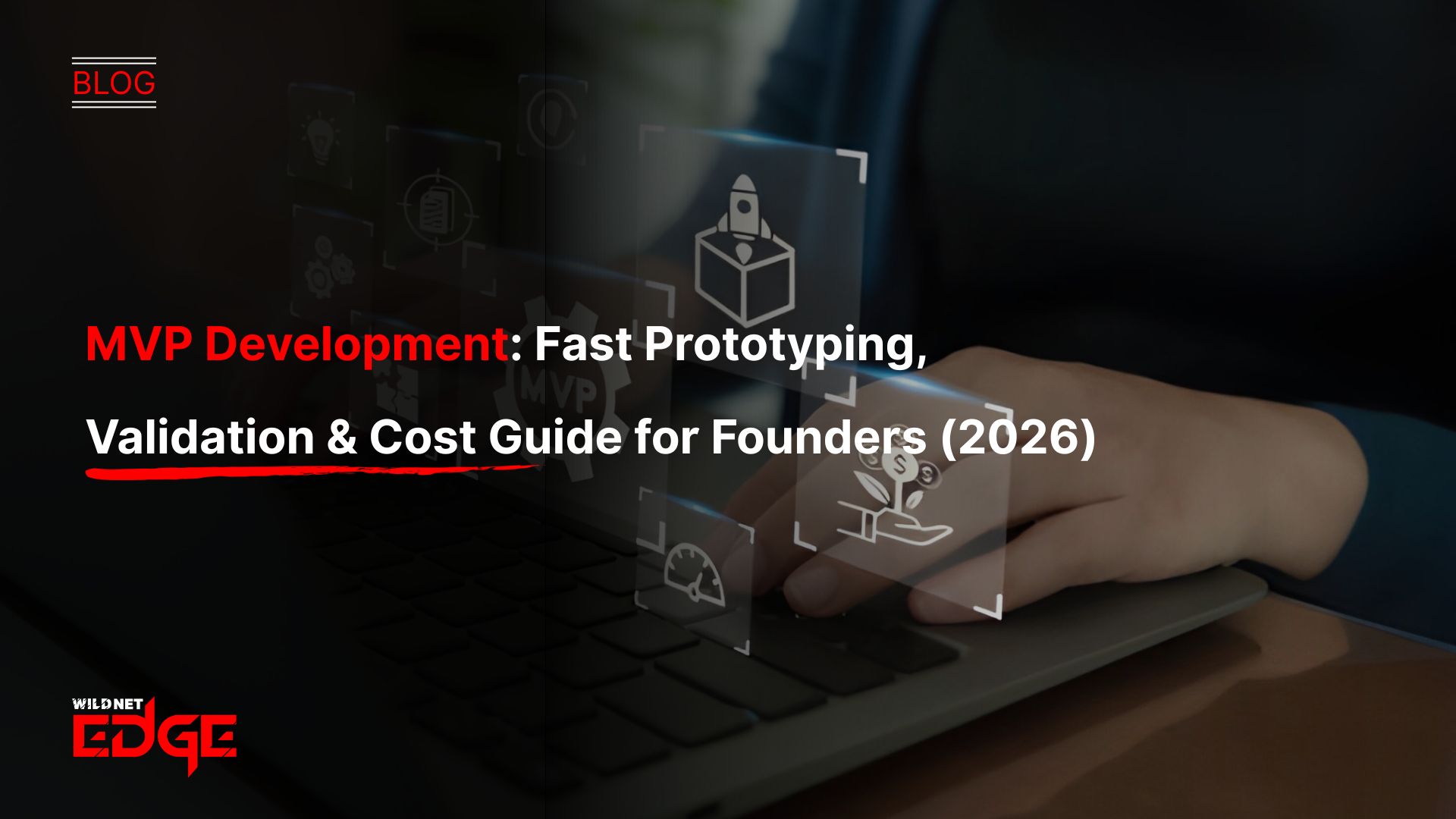TL;DR
This article is a founder’s guide to Minimum Viable Product (MVP) development—the smartest first step for startups. It explains how building a simplified version of your product helps validate ideas, test assumptions, and reach product-market fit faster. By focusing on rapid prototyping, startups can save costs, reduce risks, and accelerate time-to-market. The guide outlines key MVP stages from defining the core problem to refining based on user feedback—emphasizing how this lean approach helps attract investors and scale efficiently.
For any startup founder, the gap between a brilliant idea and a successful business is vast and uncertain. The biggest risk? Spending precious time and capital building something nobody actually wants. The most effective way to bridge this gap and navigate the uncertainty is through MVP Development. Creating a Minimum Viable Product isn’t about launching something incomplete; it’s the smartest, leanest way to test your core assumptions, learn from real users, and build a foundation for sustainable growth.
What Exactly is a Minimum Viable Product?
Described by Eric Ries in “The Lean Startup,” an MVP is the version of the product which, through the least effort, allows the team to collect the maximum amount of validated learning about the customers. It is the absolute simplest version of your product consisting of the basic features that fix one major problem for a targeted group of early adopters.
Main features of a real MVP:
- Minimum: It has only the necessary features that deliver the primary value proposition. Throw away everything else without mercy.
- Viable: It should actually function dependably, be user-friendly, and create enough value so that the first users are ready to interact with it (and maybe even pay for it).
- Product: It is not merely a design or mockup; it is a working software that is capable of being delivered and used.
The goal of minimum viable product development is not immediate profit or mass adoption, but learning.
Why the MVP Approach is Crucial for Startups
In the resource-constrained, high-risk world of startups, the MVP strategy provides critical advantages.
Accelerated Learning and Product Validation
As mentioned, the top reason startups fail is building something with no market need. An MVP forces you to test your most critical hypothesis—”Does my solution solve a real problem for my target audience?” with minimal investment. Real user interaction provides undeniable product validation (or invalidation) far more effectively than surveys or market research ever could.
Significant Cost and Time Savings
Building a full-featured application can take 6-12+ months and cost hundreds of thousands of dollars. An MVP, focusing only on core features, can often be built in 3-5 months for a fraction of that cost. This speed saves money directly and gets you to market faster, allowing you to start learning sooner. This cost-efficiency is a primary goal of MVP development services.
Reduced Development Risk
By launching a smaller, focused product, you reduce the technical complexity and the risk of major bugs or architectural flaws in the initial release. You identify and fix issues on a smaller scale before investing heavily in features that might need to be changed or discarded based on feedback.
Attracting Early Adopters and Investors
An MVP allows you to engage with early adopters who can provide invaluable feedback and become your first advocates. Furthermore, a functional MVP with even modest user traction is infinitely more compelling to investors than a mere idea on a slide deck. It demonstrates execution ability and provides initial data points.
The MVP Development Process: A Step-by-Step Guide
Building an effective MVP follows an iterative cycle.
1. Market Research & Problem Definition
- Identify the Core Pain Point: What specific, high-value problem are you solving?
- Define Your Target Audience (Early Adopters): Who feels this pain most acutely? Be specific.
- Analyze Competitors: How are others solving this problem? Where are the gaps?
2. Feature Prioritization (“Minimum” Focus)
- Map the Core User Journey: What is the single most important path a user takes to get value?
- Define Essential Features: List only the features absolutely necessary to enable that core journey. Use prioritization techniques (like MoSCoW) rigorously.
- Cut Ruthlessly: Delay everything else. Features like extensive settings, multiple integrations, or advanced reporting can wait. Effective product strategy consulting is invaluable here.
3. Design & Prototyping (Lean UX)
- Focus on Core Workflow: Design a clean, intuitive user experience for the essential features.
- Rapid MVP Prototyping: Create interactive wireframes or simple prototypes to test the flow quickly before committing to full development. Explore options like rapid prototyping and UX design services.
- Keep it Simple: Avoid overly complex visual designs for the initial MVP; focus on usability.
4. Agile Development
- Choose the Right Tech Stack: Select technologies that allow for speed but also provide a foundation for future scalability.
- Build Incrementally: Use agile sprints to build and test the core features.
- Prioritize Quality (within scope): The MVP must be stable and usable, even if feature-limited.
5. Launch and Measure
- Targeted Launch: Release the MVP to your defined early adopter segment.
- Implement Analytics: Track key engagement metrics (e.g., activation rate, feature usage, retention).
- Gather Qualitative Feedback: Use surveys, interviews, and feedback forms to understand the “why” behind the data.
6. Learn and Iterate
- Analyze Data & Feedback: Identify what’s working, what’s not, and where users are struggling.
- Prioritize Next Steps: Use the learnings to inform the next development cycle. Will you refine existing features, add new ones, or pivot based on the feedback?
Estimating MVP Development Costs
MVP development costs vary based on feature complexity, design, technology stack, and team expertise. While highly variable, understanding the cost factors helps with budgeting:
- Complexity: The main factor. More complicated main features = more expensive.
- Platform: Web application or mobile application (iOS, Android, or cross-platform). Cross-platform frequently provides mobile MVPs with cost benefits.
- Design: Personalized UI/UX increases price in relation to utilizing standard components.
- Team: Geographical area (onshore vs. offshore), developers’ skills, and team size are major determinants of project costs.
- Typical Range: A really good MVP from a competent agency could be somewhere between $30,000 and $100,000+, with the main factor being really educational above. The best way to get an accurate estimate is a comprehensive discovery phase.
Case Studies
Case Study 1: From Idea to Funded Marketing Analytics Platform
- The Challenge: A founding team had a broad idea for a marketing analytics tool but wasn’t sure which specific feature would provide the most value.
- Our Solution: We guided them through a rigorous feature prioritization process, resulting in an MVP focused only on analyzing competitor ad spend. We built this core feature quickly using Python and React. This project required expert custom software development for startups.
- The Result: The focused MVP resonated strongly with a niche group of marketers. The clear validation and early traction allowed the startup to secure seed funding to build out the broader platform based on direct user requests.
Case Study 2: Building a Lean Community App with Real User Insights
- The Challenge: An entrepreneur envisioned a complex mobile app for local community engagement but had limited initial funding.
- Our Solution: We defined an MVP centered around a simple event discovery and RSVP function, cutting features like chat, user profiles, and group creation. We used Flutter for rapid cross-platform development.
- The Result: The MVP app development launched in 4 months on both iOS and Android. User feedback quickly highlighted the need for better event filtering, which became the priority for the next iteration, saving the founder from investing in less critical features initially.
Our Technology Stack for MVP Development
We prioritize speed, modern practices, and scalability.
- Frontend: React, Vue.js, Flutter
- Backend: Node.js, Python, Ruby on Rails
- Cloud Platforms: AWS, Google Cloud, Firebase, Heroku
- Databases: PostgreSQL, MongoDB
- Analytics: Mixpanel, Amplitude, Google Analytics
Conclusion
Big the MVP Development is the mainstay of the lean startup methodology and the most sensible way to tackle the construction of a new software product. When concentrating on fast MVP prototyping, early product validation, and cost-effective management, the founders can greatly reduce the risk of their venture. It is a strict procedure of building, measuring, and learning that enables you to discover product-market fit and establish a viable business with maximum chances.
Ready to transform your idea into a validated product? At Wildnet Edge, our AI-first approach enhances our development process. We are your expert partner in building lean, intelligent MVPs that accelerate your path to success.
FAQs
An MVP should be minimal in features but not in quality or user experience for those core features. It should look professional, be bug-free within its limited scope, and solve the core problem effectively. Communicate clearly that it’s an early version focused on learning.
A prototype is often a non-functional or partially functional mockup used for internal testing or demos (like rapid prototyping and UX design outputs). An MVP is a working product deployed to real users to gather validated learning and usage data.
Success isn’t just about sign-ups. Look for strong engagement with the core feature, high user retention rates (users coming back repeatedly), positive qualitative feedback indicating you’re solving a real pain point, and ideally, early signs of willingness to pay.
It depends on your strategy, but charging (even a small amount) is often the strongest form of product validation. If users are willing to pay for even the minimal version, it’s a powerful signal that you’re solving a valuable problem.
This is valuable learning! The MVP has done its job by preventing you from wasting more resources on a flawed idea. Analyze the feedback and data: Was the problem not real? Was your solution ineffective? Was the target audience wrong? Use these insights to pivot your strategy or product direction.
Yes, absolutely. A well-architected MVP built by a professional team is the foundation of your final product. It’s not a throwaway prototype; it’s Version 1.0, designed to be iterated upon and expanded.
The best way is to invest in a paid Discovery or Scoping phase with a potential development partner. This involves collaboratively defining the detailed MVP requirements, user flows, and technical approach, which allows the partner to provide a much more reliable cost and timeline estimate.

Nitin Agarwal is a veteran in custom software development. He is fascinated by how software can turn ideas into real-world solutions. With extensive experience designing scalable and efficient systems, he focuses on creating software that delivers tangible results. Nitin enjoys exploring emerging technologies, taking on challenging projects, and mentoring teams to bring ideas to life. He believes that good software is not just about code; it’s about understanding problems and creating value for users. For him, great software combines thoughtful design, clever engineering, and a clear understanding of the problems it’s meant to solve.
 sales@wildnetedge.com
sales@wildnetedge.com +1 (212) 901 8616
+1 (212) 901 8616 +1 (437) 225-7733
+1 (437) 225-7733































